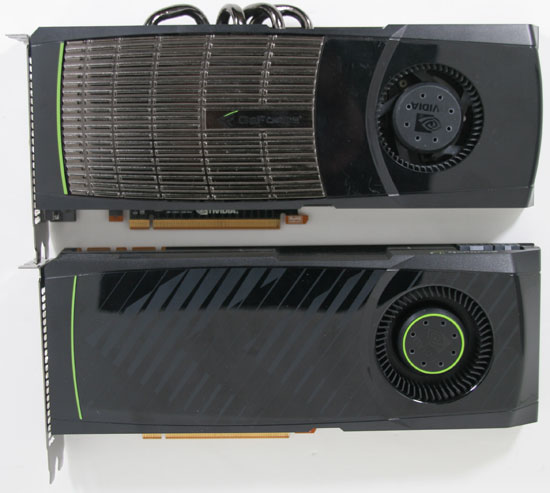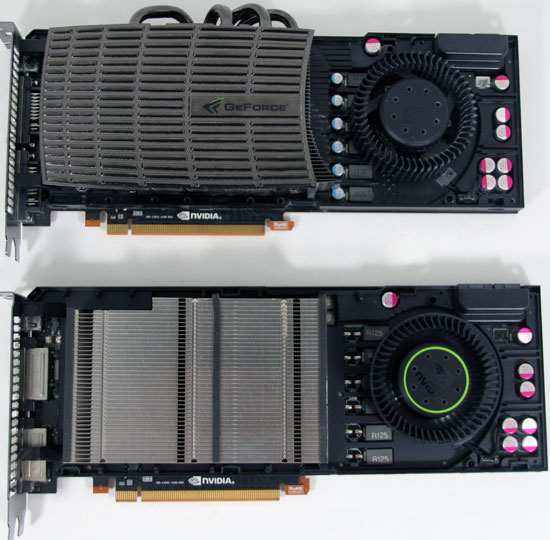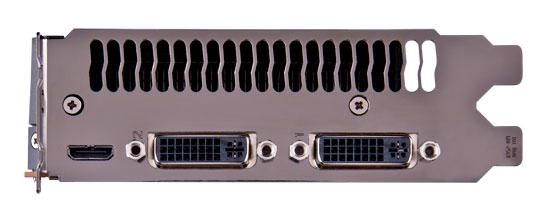NVIDIA's GeForce GTX 580: Fermi Refined
by Ryan Smith on November 9, 2010 9:00 AM ESTMeet the GTX 580
Since we’ve already discussed the cooling, let’s dive right in to the rest of the GTX 580, shall we?
Launching today will be a single GTX 580 design, the reference design. Talking to our contacts, semi-custom designs (designs using the reference PCB with a different cooler) are due in the next few weeks assuming everything goes to plan and of course there’s ample supply. And while we’re on that note, NVIDIA let us know that with their focus on cooling on the GTX 580 they aren’t going to be letting custom GTX 580 designs go out without a more thorough inspection. The acoustic performance of the reference GTX 580 is going to be the bare minimum to get a design approved – if it can’t beat the reference design, NVIDIA won’t allow it. We consider this a matter of brand protection for the company, as a bad/loud GeForce is still a GeForce all the same.

Top: GTX 480. Bottom: GTX580
With the reference design the resulting card is very close to being a GTX 285/480 hybrid. In terms of overall design it ends up looking very similar to the GTX 285. At 10.5” long it’s the same length as the GTX 480 or a smidge longer than the GTX 285, and should fit in to any cases those cards could work in. Power connectivity is the same as the GTX 480, with 6pin and 8pin PCIe sockets being located at the top of the card, providing easy access to the sockets. At 244W TDP the card draws too much for 6+6, but you can count on an eventual GTX 570 to fill that niche. Meanwhile NVIDIA has kept the 480’s detachable shroud lid, meaning you can remove the cover of the shroud without disturbing the rest of the card; it’s worth noting that it’s secured with screws rather than laches this time however.

Heatsinks Exposed! Top: GTX 480. Bottom: GTX 580
On the front side of the PCB you’ll find the 12 GDDR5 chips composing the card’s 384bit memory bus. The thermal pads connecting the memory to the shroud have once again wiped out the chip markings, so we haven’t been able to determine what these chips are, although we’re confident they’re 5Gbps like in past cards. At the center of the card is the GF110 GPU encased in a metal heatspreader, a common sight for NVIDIA’s high-end GPUs. This is an A1 revision GPU, which in NVIDIA’s counting system means it’s the first tape-out. Elsewhere on the board you’ll find the 2 SLI connectors, providing support for tri-SLI on the 580. All told while the GPU has been refined, the PCB remains largely unchanged from the GTX 480 other than removing the ventilation holes – all of the ICs are in practically the same place, and even the VRM controller is the same.
Meanwhile looking at the IO bracket for the 580, we find the same configuration as we saw on the 480. Below a full-sized vent are 2 DVI ports and a mini-HDMI port. NVIDIA slightly revised their display controller for GF110/GTX580; the good news is that HDMI 1.4a is supported, the bad news is that full audio bitstreaming is not supported so it’s the same as it was on the GTX 480: 8 channel LPCM and lossy audio formats like DD+ and DTS. This actually caught us off-guard since we were expecting the full GF104 treatment here, but it just goes to show that this is a GF100-derrivative after all. Unfortunately this also extends to the number of displays supported – NVIDIA still only supports 2 displays on one card, so you need to run in SLI if you intend to take advantage of 3DVision/NVIDIA surround across 3 monitors.

Finally, it’s with some sense of irony that we find ourselves yelling more at AMD than NVIDIA for naming shenanigans this time around, considering it was NVIDIA that brought us the 8800GT/9800GT and GeForce 200/300 product naming snafus. While NVIDIA has made some changes compared to the GTX 480, it’s a very short list; shorter than even AMD’s list for the 6800 series. At the same time, at least the GTX 580 is faster than the GTX 480 versus AMD’s 6800/5800 series. Quite frankly the GTX 580 should be the GTX 485 – the few architectural changes we’ve seen do make a difference, but then NVIDIA did a whole die shrink on the GTX 280 and only got a GTX 285 out of it. Both companies seem committed to coming out with a new family of video cards this year regardless of where the GPU powering them has actually changed. Ultimately the GTX 580 is the second flimsiest excuse for a new series number, next only to simply rebranding an existing GPU.











160 Comments
View All Comments
RussianSensation - Wednesday, November 10, 2010 - link
Very good point techcurious. Which is why the comment in the review about having GTX580 not being a quiet card at load is somewhat misleading. I have lowered my GTX470 from 40% idle fan speed to 32% fan speed and my idle temperatures only went up from 38*C to 41*C. At 32% fan speed I can not hear the car at all over other case fans and Scythe S-Flex F cpu fan. You could do the same with almost any videocard.Also, as far as FurMark goes, the test does test all GPUs beyond their TDPs. TDP is typically not the most power the chip could ever draw, such as by a power virus like FurMark, but rather the maximum power that it would draw when running real applications. Since HD58/68xx series already have software and hardware PowerPlay enabled which throttles their cards under power viruses like FurMark it was already meaningless to use FurMark for "maximum" power consumption figures. Besides the point, FurMark is just a theoretical application. AMD and NV implement throttling to prevent VRM/MOSFET failures. This protects their customers.
While FurMark can be great for stability/overclock testing, the power consumption tests from it are completely meaningless since it is not something you can achieve in any videogame (can a videogame utilize all GPU resources to 100%? Of course not since there are alwasy bottlenecks in GPU architectures).
techcurious - Wednesday, November 10, 2010 - link
How cool would it be if nVidia added to it's control panel a tab for dynamic fan speed control based on 3 user selectable settings.1) Quiet... which would spin the fan at the lowest speed while staying just enough below the GPU temperature treshold at load and somewhere in the area of low 50 C temp in idle.
2) Balanced.. which would be a balance between moderate fan speed (and noise levels) resulting in slightly lower load temperatures and perhaps 45 C temp in idle.
3) Cool.. which would spin the fan the fastest, be the loudest setting but also the coolest. Keeping load temperatures well below the maximum treshold and idle temps below 40 C. This setting would please those who want to extend the life of their graphics card as much as possible and do not care about noise levels, and may anyway have other fans in their PC that is louder anyway!
Maybe Ryan or someone else from Anandtech (who would obviously have much more pull and credibility than me) could suggest such a feature to nVidia and AMD too :o)
BlazeEVGA - Wednesday, November 10, 2010 - link
Here's what I dig about you guys at AnandTech, not only are your reviews very nicely presented but you keep it relevant for us GTX 285 owners and other more legacy bound interested parties - most other sites fail to provide this level of complete comparison. Much appreciated. You charts are fanatastic, your analysis and commentary is nicely balanced and attention to detail is most excellent - this all makes for a more simplified evaluation by the potential end user of this card.Keep up the great work...don't know what we'd do without you...
Robaczek - Thursday, November 11, 2010 - link
I really liked the article but would like to see some comparison with nVidia GTX295..massey - Wednesday, November 24, 2010 - link
Do what I did. Lookup their article on the 295, and compare the benchmarks there to the ones here.Here's the link:
http://www.anandtech.com/show/2708
Seems like Crysis runs 20% faster at max res and AA. Is a 20% speed up worth $500? Maybe. Depends on how anal you are about performance.
lakedude - Friday, November 12, 2010 - link
Someone needs to edit this review! The acronym "AMD" is used several places when it is clear "ATI" was intended.For example:
"At the same time, at least the GTX 580 is faster than the GTX 480 versus AMD’s 6800/5800 series"
lakedude - Friday, November 12, 2010 - link
Never mind, looks like I'm behind the times...Nate007 - Saturday, November 13, 2010 - link
In the end we ( the gamers) who purchase these cards NEED to be be supporting BOTH sides so the AMD and Nvidia can both manage to stay profitable.Its not a question of who Pawns who but more importantly that we have CHOICE !!
Maybe some of the people here ( or MOST) are not old enough to remember the days when mighty
" INTEL" ruled the landscape. I can tell you for 100% fact that CPU's were expensive and there was no choice in the matter.
We can agree to disagree but in the END, we need AMD and we need NVIDIA to keep pushing the limits and offering buyers a CHOICE.
God help us if we ever lose one or the other, then we won't be here reading reviews and or jousting back and forth on who has the biggest stick. We will all be crying and complaining how expense it will be to buy a decent Video card.
Here's to both Company's ..............Long live NVIDIA & AMD !
Philip46 - Wednesday, November 17, 2010 - link
Finally, at the high end Nvidia delivers a much cooler and quiter, one GPU card, that is much more like the GTX 460, and less like the 480, in terms of performance/heat balance.I'm one where i need Physx in my games, and until now, i had to go with a SLI 460 setup for one pc and for a lower rig, a 2GB 460 GTX(for maxing GTA:IV out).
Also, i just prefer the crisp Nvidia desktop quality, and it's drivers are more stable. (and ATI's CCC is a nightmare)
For those who want everything, and who use Physx, the 580 and it's upcoming 570/560 will be the only way to go.
For those who live by framerate only, then you may want to see what the next ATI lineup will deliver for it's single GPU setup.
But whatever you choose, this is a GREAT thing for the industry..and the gamer, as Nvidia delivered this time with not just performance, but also lower temps/noise levels, as well.
This is what the 480, should have been, but thankfully they fixed it.
swing848 - Wednesday, November 24, 2010 - link
Again, Anand is all over the place with different video cards, making judgements difficult.He even threw in a GTS 450 and an HD 4870 here and there. Sometimes he would include the HD 5970 and often not.
Come on Anand, be consistent with the charts.